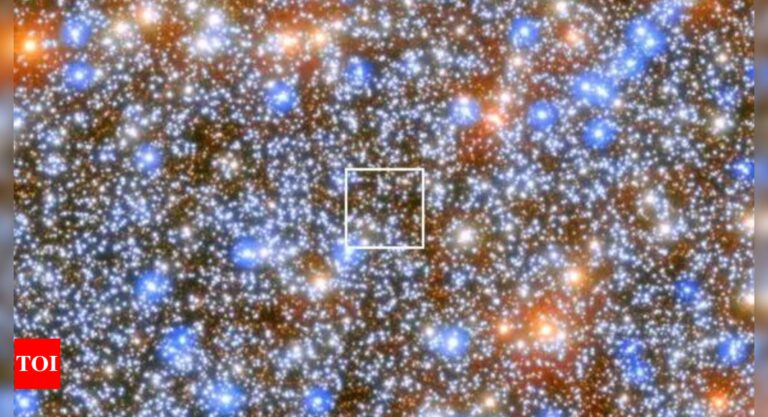
[ad_1]
Nasa‘s Hubble Space Telescope has discovered compelling evidence for the presence of an intermediate-mass black hole at the heart of the globular star cluster Omega Centauri. This finding represents a significant step in understanding the formation and evolution of black holes.
Omega Centauri, the largest globular cluster in the Milky Way, is known for its dense collection of stars.Astronomers used Hubble’s precise observations to study the motions of these stars, revealing a gravitational influence consistent with a black hole. The data suggest this black hole is about 47,000 times the mass of the Sun, classifying it as an intermediate-mass black hole.
Intermediate-mass black holes are a crucial missing link in black hole evolution theories, bridging the gap between smaller stellar-mass black holes and the supermassive black holes found at the centers of galaxies. The existence of such a black hole in Omega Centauri could provide insights into how these cosmic giants form and grow.
The discovery was made possible through Hubble’s advanced capabilities in capturing high-resolution images and detailed star movements within the cluster. This breakthrough adds to Hubble’s legacy of significant astronomical discoveries and enhances our understanding of the universe’s complex dynamics.
What are intermediate-mass black holes?
Intermediate-mass black holes (IMBHs) are black holes whose masses range between that of stellar-mass black holes (a few to tens of solar masses) and supermassive black holes (millions to billions of solar masses). Specifically, IMBHs are thought to have masses between 100 and 100,000 times that of our Sun. These black holes are considered a crucial missing link in our understanding of black hole formation and evolution.
Why are they significant?
IMBHs help bridge the gap between stellar-mass black holes and supermassive black holes, providing insights into how black holes grow over time. Understanding IMBHs could explain the evolutionary pathway from small to large black holes.
Formation theories
The existence of IMBHs supports various theories about black hole formation. They might form through the merger of smaller black holes or from the collapse of massive stars in the early universe. Studying IMBHs helps refine these theories.
Gravitational wave sources
IMBHs are potential sources of gravitational waves, which are ripples in space-time caused by violent cosmic events. Detecting gravitational waves from IMBH mergers can provide valuable data on the properties and behavior of these elusive objects.
Galactic evolution
IMBHs could play a role in the formation and evolution of galaxies. If present in the centers of globular clusters or small galaxies, they might influence the dynamics and evolution of their host systems.
Accretion processes
Studying IMBHs helps us understand accretion processes (how black holes gather material) on different scales. This knowledge is crucial for comprehending how black holes interact with their environments and grow.
Testing general relativity
IMBHs provide a testing ground for general relativity in a regime not accessible by studying either stellar-mass or supermassive black holes alone. Observing their behavior can validate or challenge our current understanding of gravity.
Omega Centauri, the largest globular cluster in the Milky Way, is known for its dense collection of stars.Astronomers used Hubble’s precise observations to study the motions of these stars, revealing a gravitational influence consistent with a black hole. The data suggest this black hole is about 47,000 times the mass of the Sun, classifying it as an intermediate-mass black hole.
Intermediate-mass black holes are a crucial missing link in black hole evolution theories, bridging the gap between smaller stellar-mass black holes and the supermassive black holes found at the centers of galaxies. The existence of such a black hole in Omega Centauri could provide insights into how these cosmic giants form and grow.
The discovery was made possible through Hubble’s advanced capabilities in capturing high-resolution images and detailed star movements within the cluster. This breakthrough adds to Hubble’s legacy of significant astronomical discoveries and enhances our understanding of the universe’s complex dynamics.
What are intermediate-mass black holes?
Intermediate-mass black holes (IMBHs) are black holes whose masses range between that of stellar-mass black holes (a few to tens of solar masses) and supermassive black holes (millions to billions of solar masses). Specifically, IMBHs are thought to have masses between 100 and 100,000 times that of our Sun. These black holes are considered a crucial missing link in our understanding of black hole formation and evolution.
Why are they significant?
IMBHs help bridge the gap between stellar-mass black holes and supermassive black holes, providing insights into how black holes grow over time. Understanding IMBHs could explain the evolutionary pathway from small to large black holes.
Formation theories
The existence of IMBHs supports various theories about black hole formation. They might form through the merger of smaller black holes or from the collapse of massive stars in the early universe. Studying IMBHs helps refine these theories.
Gravitational wave sources
IMBHs are potential sources of gravitational waves, which are ripples in space-time caused by violent cosmic events. Detecting gravitational waves from IMBH mergers can provide valuable data on the properties and behavior of these elusive objects.
Galactic evolution
IMBHs could play a role in the formation and evolution of galaxies. If present in the centers of globular clusters or small galaxies, they might influence the dynamics and evolution of their host systems.
Accretion processes
Studying IMBHs helps us understand accretion processes (how black holes gather material) on different scales. This knowledge is crucial for comprehending how black holes interact with their environments and grow.
Testing general relativity
IMBHs provide a testing ground for general relativity in a regime not accessible by studying either stellar-mass or supermassive black holes alone. Observing their behavior can validate or challenge our current understanding of gravity.
[ad_2]
